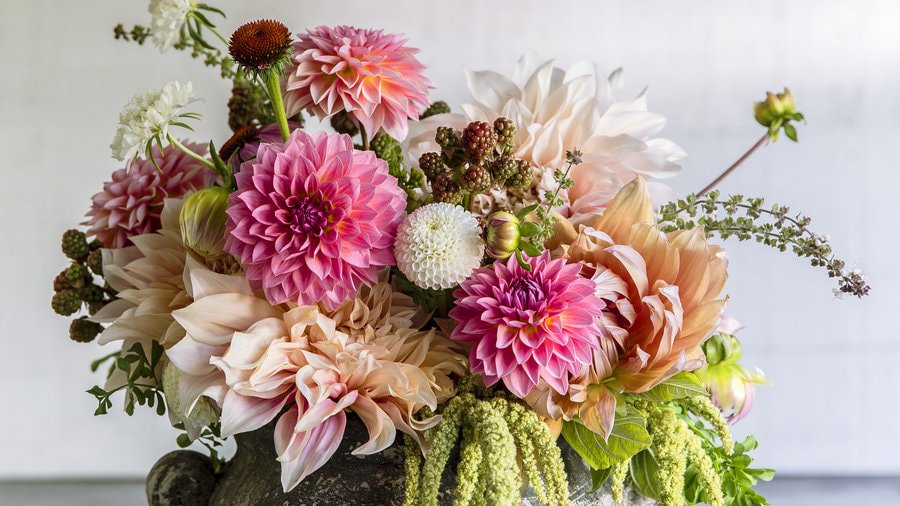With Valentine’s Day right around the corner, you might be the recipient of flowers, or maybe you purchased flowers for your significant other. Whether you received or purchased cut flowers, there are care tips that can help extend the life of the blooms.
Check out any florist or the floral section of grocery stores gearing up for Valentine’s Day sales, and you’ll find a huge selection of cut flowers. While at a nearby florist shop recently I noticed rose bouquets, by far, are the most plentiful, but there are also arrangements of lilies, tulips and mixed flowers. If fragrance is important, take a whiff before making your selection, because most of the roses at stores have no fragrance, especially the reds. But the florist pointed out a pale pink and a yellow rose that had a faint fragrance.
Cut roses should last for at least ten days and, depending on the variety and care, may look good for up to 15-20 days. Other popular flowers to consider include tulip, alstroemeria, carnation, hydrangea, ranunculus, daffodil, stock, lily, dianthus, snapdragon and peony. If you received cut flowers and want to prolong their life, follow these simple instructions.
Flowers wrapped in paper/cellophane should be prepped ASAP by making a fresh cut, removing the lower one to two inches of the stem. Never use scissors to make the pruning cut because they will crush the stem, which reduces water absorption. Instead, use sharp by-pass pruners or floral shears and cut stems at a 45-degree angle while holding the stem end under water. The 45-degree angle will prevent the cut surface from sitting on the base of the container and enable better water uptake. Strip off any leaves that will sit below the water line of the vase to prevent bacterial growth.
Always start with a clean vase. To kill any bacteria, sterilize the container with 1 part bleach to 10 parts water and then rinse several times with hot water.
Make sure you get a packet of floral preservative with the arrangement. The floral preservative does three important things: it kills bacteria, it acidifies the water, and it provides a source of sugar for the flowers. Tap water is usually around 7 pH, and flowers absorb water best at a pH of around 3 to 5.5. Very alkaline water (above pH 7) can also affect the flower color, so it’s important to adjust. Water quality is important too. Don’t use water from a water softener because the sodium can be toxic to some flowers. Fluoride, an ingredient in tap water, is also toxic to some flowers. So it’s best to use rain water or purified water instead.
Mix floral preservative with warm water (100 to 110 degrees) according to directions. Skip the warm water on flowers such as tulips and hyacinths because they prefer cold water. Place flowers in the warm water as soon as the new cut is made. For maximum water uptake, place the flowers in a cool area away from direct sunlight, and avoid areas exposed to vents blowing hot or cold air. Don’t place your bouquet near ripening fruit because it produces ethylene that will shorten the life of the flowers.
Most flowers can be mixed without any repercussions, but one that should be kept in solitary is daffodil. If you have ever cut these, you’ve probably noticed they have a very sticky sap. This sap in mixed arrangements will clog up other flowers, preventing them from taking up water. If you insist on mixing daffodils with other flowers, place them in a vase by themselves for six hours or overnight. Then they can be mixed in arrangements if you are using floral foam.
To extend the life of the flowers, make a fresh angled cut (underwater) every two to three days. Remove one to two inches of the stem plus strip any leaves that will sit in water. Mix up a fresh batch of floral preservative using warm water and place the cut flowers back in the container. If you forget to do this, the water will start looking murky and develop a bad smell. This indicates the bacterial levels are high and there is little water uptake, so plants are on the downhill cycle.
If you enjoy having cut flowers in the home, select landscape plants that make good cut flowers. Examples of annuals include Angelonia, black-eyed Susan, cleome, gallardia, dianthus, cosmos, dahlia, delphinium, gerbera daisy, amaranth, marigold, salvia, snapdragon, statice, stock, sunflower, sweet pea and zinnia. Some perennial options include agapanthus, amaryllis, bird of paradise, camellia, coneflower, crinum lily, daffodil, firespike, gardenia, ginger, gladiolus, goldenrod, jacobinia, hydrangea, iris, liatrus, lily, lion’s ear, penta, rose, salvia, stokes aster, and yarrow.
If you grow and cut your own, the best time to cut flowers is in the morning when the flowers and stems are full of water. Place them immediately in a clean container with water. For spike-type flowers such as gladiolus and delphinium, some of the flowers should be open and showing color. Most of these spike-type flowers open from the bottom to the top. Other flowers with individual blooms such as sunflower and zinnia are best cut when they are completely open.
If you didn’t receive cut flowers for Valentine’s Day, treat yourself to a colorful bouquet to brighten your home.
Source: Jacksonville

